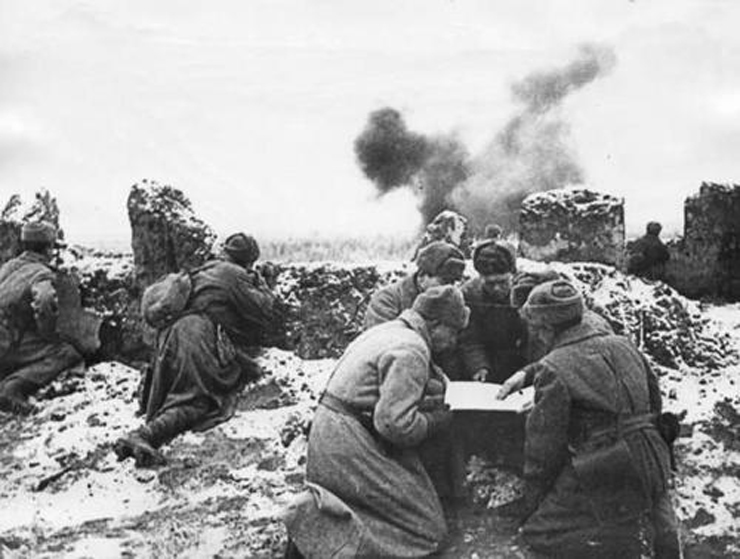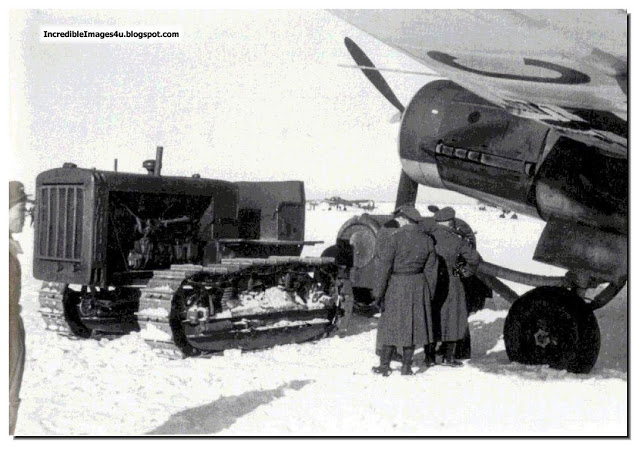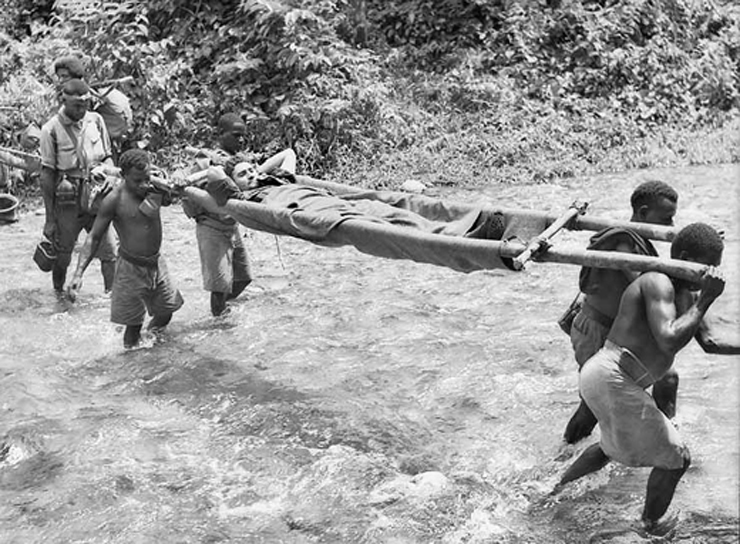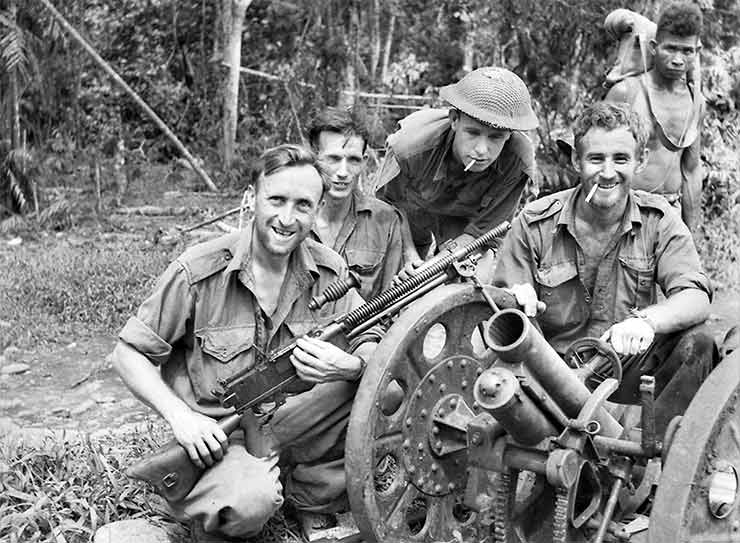Air Operations, CBI
- 6 11th Medium Bomb Squadron B-25s and 17 23rd Fighter Squadron P-40s attack the Tienho airfield at Canton, China and claim the destruction of more than 40 Japanese aircraft on the ground. 23rd Fighter Group P-40s shoot down 3 Japanese bombers over Kweilin, China between 0130 and 0210 hours.
- After feinting toward Hong Kong, 9 11th Medium Bomb Group B-25s and 7 23rd Fighter Squadron P-40s attack shipping in the Gulf of Tonkin near Haiphong, French Indochina claiming 1 freighter sunk and 2 damaged.
Air Operations, Europe
BOMBER COMMANDEvening Ops:
- 35 aircraft are sent to the Biscay ports and the Frisians to lay mines. There are no losses.
Air Operations, Far East
- American aircraft dive-bomb the bridge at Hankow and the airfield at Canton. RAF Wellingtons bomb Meiktila airfield, Burma, starting large fires.
- There is a Japanese night raid on Kweilin, a US air base in southwest China.
Air Operations, New Guinea
22nd Medium Bomb Group B-26s and 3rd Light Bomb Group A-20s attack the area around Sanananda.
[Air Operations, Solomons
6 Cactus Air Force SBDs attack a new Japanese base at Munda, New Georgia.
[Battle of the Atlantic
The US tanker Caddo (19,172t), en route from Baytown, Texas to Iceland, is torpedoed and sunk by U-518 and abandoned with the 42-man crew and 17-man Armed Guard taking to lifeboates. The ship's master and another officer are taken prisoner. Only 6 of those taking to lifeboats are ever rescued and those are picked up by the Spanish motorship Motomar on December 8.
[Eastern Front
The important bridge over the Don at Kalach is captured by Soviet forces coming from the north in a surprise attack. After crossing this bridge advance units link up with tank forces of 51st Army and the encirclement of Stalingrad begins. The Soviets believe that they have about 85,000 Germans cut off in the city when in fact the total is nearer 300,000. Being surrounded by the Soviet 5th Tank Army and the 21st Army, 5 Rumanian divs of the Rumanian 3rd Army's total of 7 surrender around Raspopinskaya, south of Serafimovich.
The Soviets intend, as their first priority, methodically to destroy the Stalingrad garrison before continuing their offensive to the west. Zhukov supports this unambitious scheme because he is well aware of the limitations of the Soviet forces in wide-ranging operations. Despite this priority, the false assessment of German positions leaves the siege forces short.
The Germans trapped at Stalingrad are attacked in the rear by the Soviet 65th and 64th Armies. The commander of Army Group B, von Weichs, urges von Paulus, 6th Army commander, to break out of the encirclement before the Russians can bring up new forces around the besieged city. Hitler, however, has assumed personal command of the army. When Field Marshal Göring assures him that the Luftwaffe will be able to get supplies, ammunition and material into Stalingrad at a rate of 700 tons per day, he orders von Paulus to hold out where he is, in the expectation that Army Group B will resume the offensive to relieve him.
|
|
Hitler goes on to order the setting up of 'Fortress Stalingrad', and insists that not a yard of ground shall be given up. Meanwhile Field Marshal von Manstein is recalled from the Leningrad front and assumes command of the Don Army Group, consisting of the 4th Panzer Army, part of the 6th Army and several armored and mechanized groups. He is given the task of relieving Stalingrad and restoring the original front.
Von Manstein organizes his forces in two big operational groups, the Hoth Group south of the Don and Hollidh Group north of it. The plan, largely dictated by Hitler, is to attack Gen Yeremenko's Stalingrad Front group, then, unexpectedly, to withdraw to attack Rokossovsky's Don Front in concert with von Paulus' army, which will by then have broken through the Soviet ring round Stalingrad.
The Russians are faced with a very important decision on strategy: whether they should concentrate their forces from the southern front on liquidating the German troops trapped at Stalingrad, or whether they should isolate Stalingrad and launch a massive attack to cut off the German forces falling back from the Caucasus.
The first alternative prevails: the immediate liquidation of the Germans left in Stalingrad because the Russians are convinced that the elimination of von Paulus' 6th Army will only require a few days. The German forces are tightly encircled and a further 'external' ring, with a circumference of about 285 miles, is thrown around the city to resist any attempt of the besieged forces to break out. This decision, which, in fact, permits the Germans to withdraw their forces from the Caucasus, is based on an almost incredible error in estimating the strength of the beleaguered German army. The Russians surround Stalingrad with a relatively small force of 480,000 men, thinking that there are approximately 90,000 Germans in Stalingrad. It is not until January 26th that the Russians realize that 330,000 German soldiers are trapped in the city. German sources say 284,000.
In the Siege of Leningrad German heavy artillery and bombers are in action before dawn. 50,000 shells hit the city during 1942. Shelling takes place on 254 days.
SOUTHERN SECTORSome 27,000 Romanian soldiers surrender, signalling the end of their 3rd Army, which has lost 90,000 casualties since the start of URANUS. Red Army units link up at Kalach, thus trapping the German 6th, part of the 4th Panzer and what is left of the Romanian 4th Armies
256,000 German troops, 22,000 Romanians, 100 tanks, 1,800 artillery pieces, 10,000 motor vehicles and 23,000 horses.
Gen Paulus put his forces into a giant hedgehog defensive posture as part of the grandly titles 'Fortress Stalingrad'. However, he has serious problems. First, establishing an effective defensive perimeter at Stalingrad is difficult due to a desperate shortage of infantry and the lack of prepared positions. Second, to the south and west lay almost completely treeless, shelter-free steppes. Third, a lack of fuel, which prevents the rapid deployment of his three panzer and three panzergrenadier divisions as mobile reserves. Fourth, a general shortage of artillery ammunition also weakens the German defense.[MORE]
[France, Politics
Darlan announces that French West Africa now accepts his authority.
[Guadalcanal
After the 245th Field Artillery Battalion and L Battery and the 1st and 2nd Battalions, 11th Marines, fire a 30-minute concentration on the Japanese lines,, the 8th Marines passes through the 164th Infantry to continue the attack westward but is unable to advance. The marines deliver successive attacks throughout the day. The Japanese defend vigorously putting fire all along the entire American line. The Americans fail to gain any ground. The American headquarters concludes further attacks would be fruitless with the resources at hand. The troops are ordered to dig in and hold the Hill 66-80-81-Point Cruz line to await reinforcements.
By this time, 84 US and New Zealand planes are operating from Guadalcanal.
[New Guinea
The main body of the Australian 25th Brigade arrives at the front and begins the assault on Gona against determined resistance. The 3rd Battalion of the 126th Infantry, US 32nd Division, continues toward Sanananda. Company L, on the right, is pinned down by enemy fire at the edge of the food dump.
The airfield at Popondetta becomes operational, and 4 guns are flown in and emplaced just south of Soputa. The 2nd Battalions of both the 126th and 128th Regiments are combined to form Urbana Force under the command of the CO, 128th Infantry. The 2nd Battalion of the 128th Infantry is slowed by extremely difficult terrain as it advances against the Triangle along the main track with swamps on either side of it.
Warren Force commander, Gen MacNider, is wounded while inspecting the front and is replaced by Col J. Tracy Hale, Jr. After an ineffective preparatory fire against enemy bunkers, the 1st Battalion of the 128th Infantry and Col Carrier's detachment of the 1st Battalion, 126th Infantry, attack along the coast toward Cape Endaiadere, gaining some 300 yards against intense fire. The Australian 2/6th Independent Company makes limited progress toward the east end of New Strip.
|
|
North Africa
ALGERIAThe Allied general headquarters is transferred from Gibraltar to Algiers.
An American M3 and Crew |
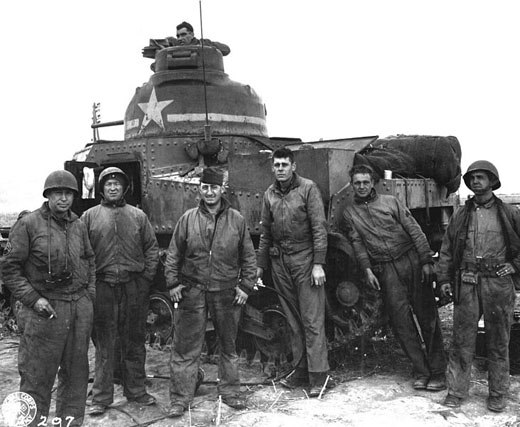 |
The retreating Axis forces, taken in flank by the 7th Arm Div of the British X Corps, around Agedabia the Axis troops fall back to the El Agheila position where Rommel hopes he can hold up the enemy advance. Montgomery halts his advance to reorganize his forces, which have now chased their enemy almost 600 miles in 14 days. The British advance has been perhaps too cautious although German demolitions and booby traps have been one cause of delay.
TUNISIABritish and French commands determine their respective spheres of command: all troops north of a line from Le Kef to Zaghouan will be under British command, those south of the line under French command.
[United States, Home Front
The US Coast Guard accepts women into service under the title SPARS (Semper Paratus Always Ready). Capt Dorothy Stratton is the commander.
[West Africa
In Senegal, Dakar, a vital base in French West Africa, is occupied by the Allies without bloodshed following a decision by Governor-General Boisson to abandon his former allegiance to Vichy.
[